My research activities
Follow the links below to jump to the latest results.
Dynamical evidence of spiral-arm-driving and gap-opening planetary companions in two systems
First dynamical detection of a companion driving a spiral arm
Performance of reference-star differential imaging on SPHERE
First confirmation of the AGN activity among GRB host galaxies
Postdoc Research (2023-present)
Water ice in the debris disk around HD 181327
(Xie et al. 2025; Nature, arXiv, ADS)
Although water ice has been commonly found in Kuiper belt objects and comets in the Solar System, no definitive evidence for water ice in debris disks has been obtained to date. Here I report the discovery of water ice in the HD 181327 debris disk using the near-infrared spectrograph onboard the James Webb Space Telescope. I detected the solid-state broad absorption feature of water ice at 3 µm including a distinct Fresnel peak at 3.1 µm, which is indicative of large, crystalline water-ice particles. Gradients in the water-ice feature as a function of stellocentric distance reveal a dynamic environment in which water ice is destroyed and replenished. I estimated the water-ice mass fractions as ranging from 0.1% at approximately 85 au to 21% at approximately 113 au, indicating the presence of a water-ice reservoir in the HD 181327 disk beyond the snow line. The icy bodies that release water ice in HD 181327 are probably the extra-solar counterparts of water-ice-rich Kuiper belt objects in our Solar System.
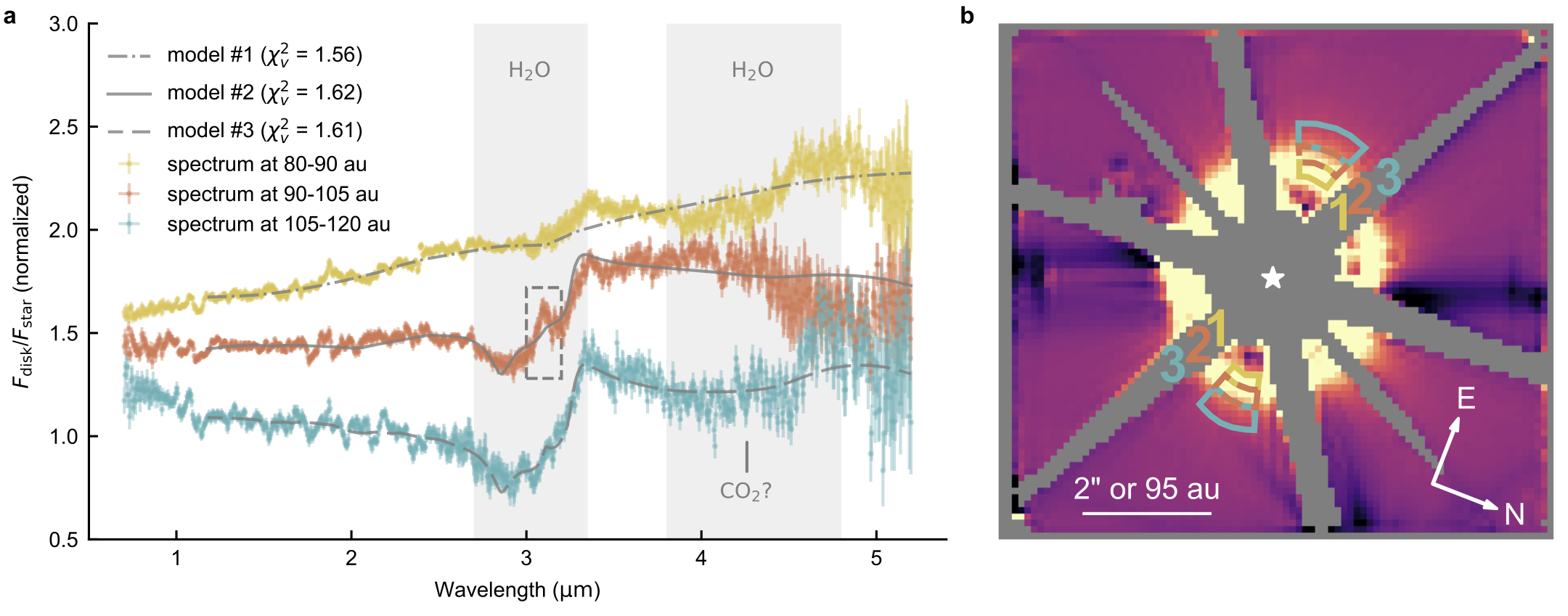
Dynamical evidence of spiral-arm-driving and gap-opening planetary companions in two systems
(SAO 206462; Xie et al. 2025; Invited paper; Universe, arXiv, ADS)
(V1247 Ori; Ren, Bin; Xie, Chen et al. 2024; A&A, arXiv, ADS)
Young exoplanets gravitationally interact with their surrounding environments, leaving observable signatures on protoplanetary disks. Among these signatures, a pair of nearly symmetric spiral arms can be driven by a giant protoplanet.
Not just one but two protoplanetary disks have been found to have dynamically predicted orbits of spiral-arm-driving planetary companions that overlap with their ALMA gaps. Based on the polarimetry data obtained with VLT/SPHERE in the SAFFRON survey (PI: B. Ren), I analyzed multi-epoch observations of two double-spiraled protoplanetary disks (SAO 206462 and V1247 Ori) and measured their spiral pattern motions. The pattern motion corresponds to a planetary companion at ~66 au in SAO 206462 and ~118 au in V1247 Ori, assuming a circular orbit. The locations of the predicted planetary companion agree with the gap in the ALMA dust-continuum observations, providing joint support for the hypothesis that a companion drives the scattered-light spirals while carving a millimeter dust gap.

PhD Research (2020-2023)
Highlights from my PhD projects:
I thoroughly studied the performance of reference-star differential imaging (RDI) on VLT/SPHERE. On average, RDI can outperform angular differential imaging (ADI) in detecting point sources at short angular separations (<0.4”), with an average gain of ~0.8 mag at 0.15”. In disk imaging, RDI can reveal more disk features and provide a more robust recovery of the disk morphology.
The RDI reference library I built can be easily implemented into legacy or future SPHERE observations without additional costs, achieving better performance than that of ADI.
The RDI-DIsNMF technique is optimized for the direct imaging of circumstellar disks in total intensity by minimizing self-subtraction and overfitting that has plagued previous methods. As a result, RDI-DIsNMF provides accurate photometry and morphology of the disk.
I provided the first dynamical detection of a companion driving a spiral arm in a protoplanetary disk
First dynamical detection of a companion driving a spiral arm
(Xie, C. et al. 2023; A&A, arXiv, ADS)
I reported multi-epoch observations of the binary system HD 100453 using VLT/SPHERE. By effectively removing starlight contamination and recovering the spiral features, I measured the motion of the spirals over a span of 4 yr for dynamical motion analysis. The spiral pattern motion is consistent with the orbital motion of the eccentric companion. This direct observational evidence supports the long-standing theory on the origin of spiral features in protoplanetary disks. With the pattern motion of companion-driven spirals being independent of companion mass, it is feasible to search for hidden spiral-arm-driving planets that are beyond the detection of existing ground-based high-contrast imagers.
The RDI-DIsNMF technique enables the accurate recovery of the disk morphology and facilitates the dynamical analysis of the spiral and companion motions in HD100453.

Reference-star differential imaging on SPHERE
(Xie, C. et al. 2022; A&A, arXiv, ADS)
I characterized the performance of reference-star differential imaging (RDI) on SPHERE/IRDIS data in direct imaging of exoplanets and disks. I made use of all the archival data in H23 obtained by SPHERE/IRDIS in the past five years to build a master reference library and perform RDI. In the point-source detection, RDI can outperform ADI at small angular separations (<0.4”) with a gain of ~0.8 mag over ADI at 0.15” separation for observations under median conditions. In disk imaging, RDI can reveal more disk features and provide a more robust recovery of the disk morphology. We resolved 33 disks in total intensity (19 planet-forming disks and 14 debris disks).
Studying stellar jet in HD 163296 with MUSE
(Xie, C. et al. 2021; A&A, arXiv, ADS)
I led the study of the stellar jet in HD 163296 with VLT/MUSE. It was the first attempt to use the MUSE narrow field mode observation to study stellar jets. I applied the modified high-resolution spectral differential imaging (HRSDI) technique that I developed in prveious work to image the stellar jet. I demonstrated the capability of MUSE in imaging extended sources, such as stellar jets.
One of the science highlights is that we constrain the jet launching region to be less than 1 au in radius, thanks to the high spatial resolution of MUSE.
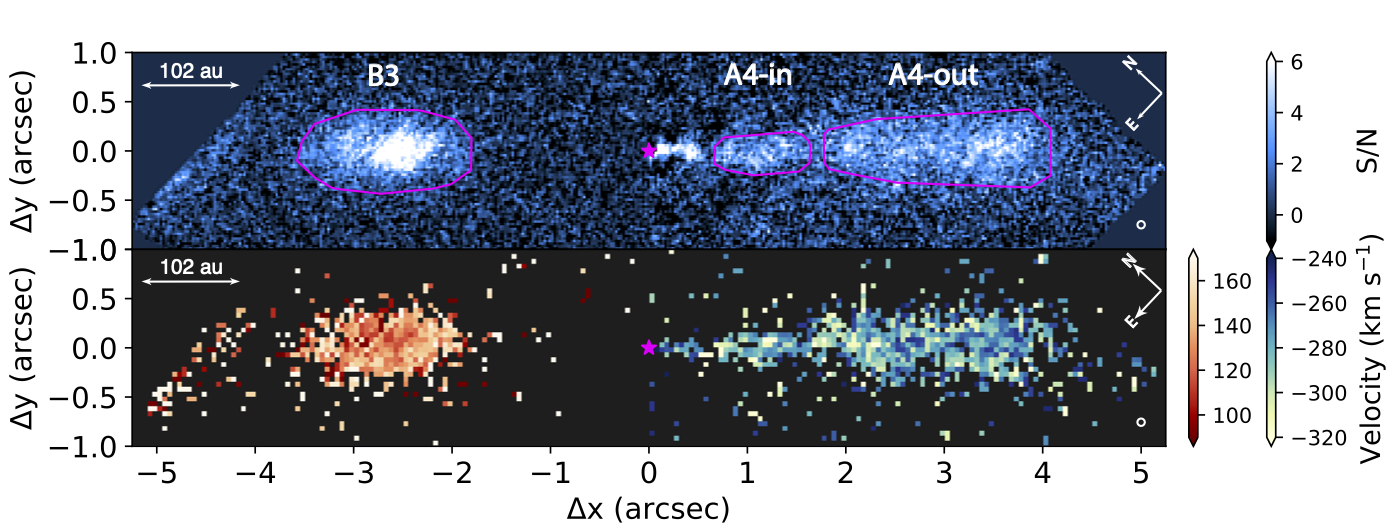
Master Research (2018-2020)
Searching for proto-planets with MUSE
(Xie, C. et al. 2020; A&A, arXiv, ADS)
I conducted a small search for proto-planets around 5 stars with VLT/MUSE. Unfortunately, we didn’t find any new planet except for PDS 70 b and c. MUSE has some instrumental issues that limit the contrast that appear in cases with strong point sources. I modified the HRSDI technique to better handle the instrumental artifacts and improve the contrast.
The HRSDI technique when applied to MUSE data allows us to reach the photon noise limit at small separations (i.e., <0.5”; see the right plane below). With the combination of high-contrast imaging and medium spectral resolution, MUSE can achieve fainter detection limits in apparent line flux than SPHERE/ZIMPOL by a factor of 5 (see, the left plane below).
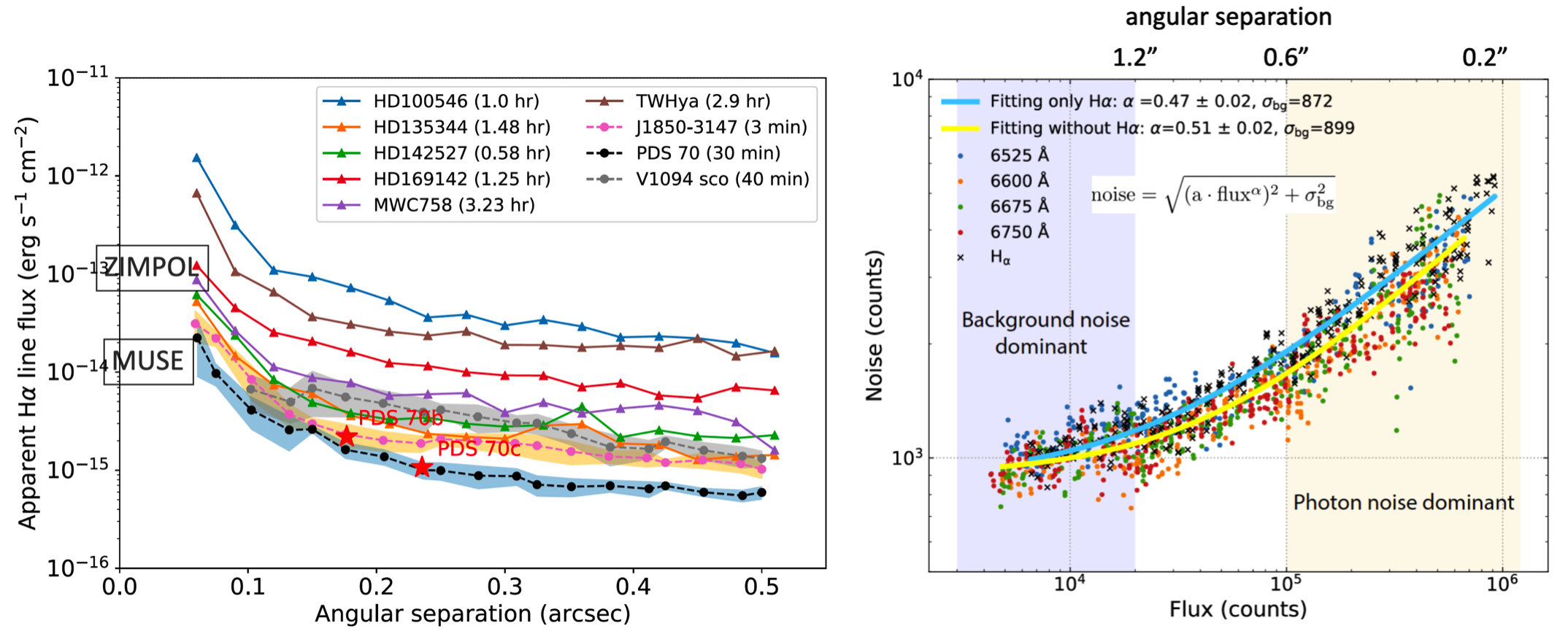
Discovery of two new radio halos
(Xie, C. et al. 2020; A&A, arXiv, ADS)
We reported the discovery of two new radio halos in the frontier fields clusters Abell S1063 and Abell 370. I processed and analyzed the radio data obtained by VLA and GMRT in 325 MHz, 1.5 GHz, and 3 GHz. Besides the discovery, I also found the radio halo in Abell S1063 has spectral steeping, which suggests the formation of the radio halo is caused by the turbulent reacceleration.
To further confirm the spectral steepening, I led the follow-up observations (~16 hours) with VLA and GMRT to increase the wavelength coverage from 0.15 to 6 GHz.
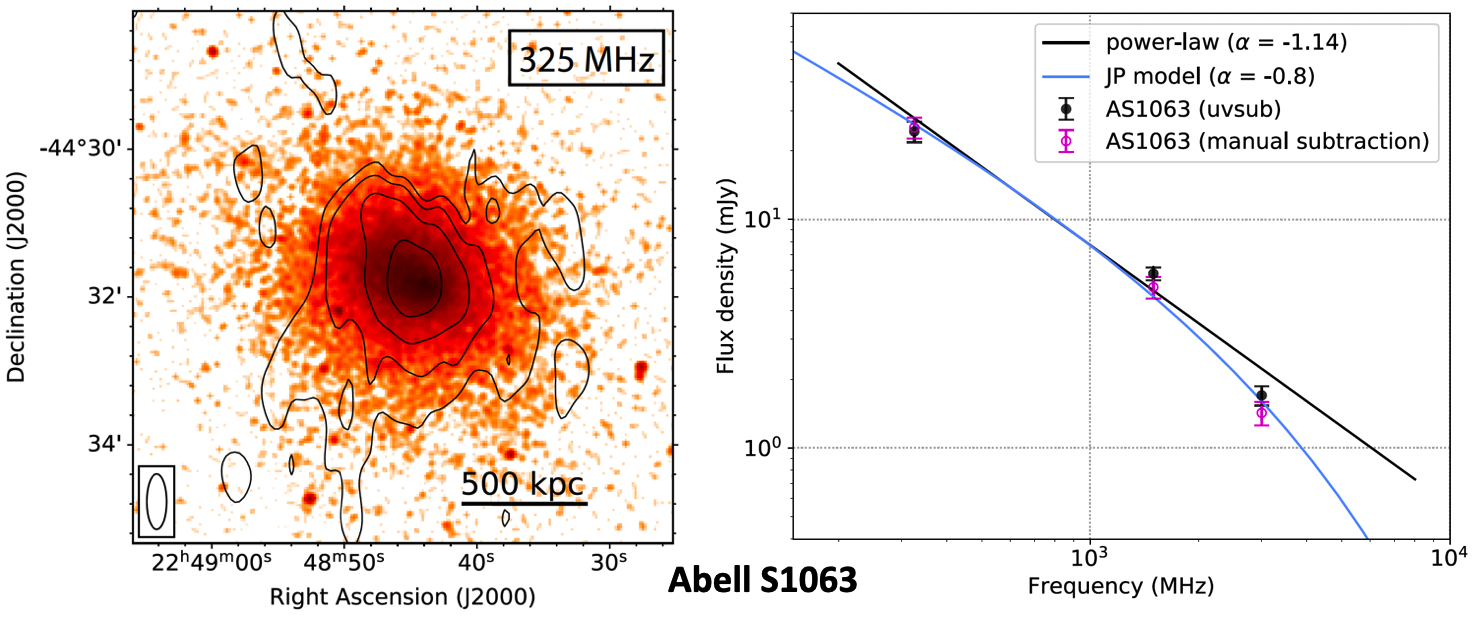
Undergraduate Research
First confirmation of the AGN activity among GRB host galaxies
(Xie, C. et al. 2016; ApJL, arXiv, ADS)
I found a weird GRB host galaxy from the WISE all sky survey. My SED modeling confirmed the nature of the AGN, making the first reported GRB host galayx that contains an AGN. This work explores an interesting connection that may exist between GRB and AGN activities of the host galaxy, which can help in understanding the host environment of the GRB events and the roles of AGN feedback.
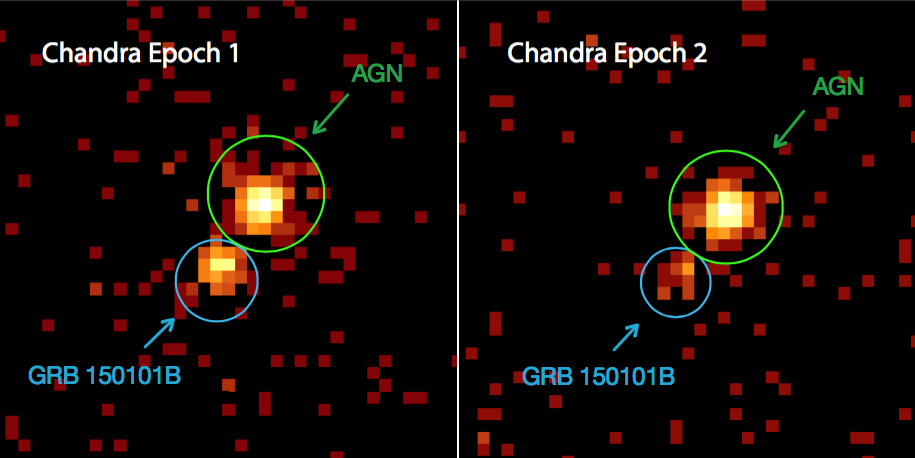
Last updated around June 2025.
